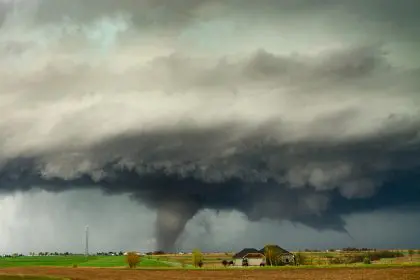New York residents are reeling from a devastating one-two punch of severe weather that has left entire communities without power while a dangerous heat wave threatens to make conditions even more unbearable. Governor Kathy Hochul’s declaration of a state of emergency across 32 counties reflects the serious nature of this weather crisis that has already claimed lives and left tens of thousands of families struggling without basic necessities.
The emergency declaration covers nearly two-thirds of New York‘s counties, affecting millions of residents who are now dealing with the aftermath of destructive overnight storms while preparing for what meteorologists are calling a potentially life-threatening heat wave. This combination of weather extremes has created a perfect storm of dangerous conditions that could prove deadly for vulnerable populations across the state.
Families throughout the affected regions are facing the harsh reality of extended power outages during what promises to be one of the hottest stretches of weather this year. The timing couldn’t be worse, as residents who lost electricity during the overnight storms now have no way to cool their homes as temperatures soar to dangerous levels.
Overnight storms unleash destruction across New York
The severe thunderstorms that swept across New York overnight brought a devastating combination of torrential rainfall, damaging winds, and widespread destruction that has left communities struggling to assess the full extent of the damage. These powerful weather systems moved through the state with unprecedented intensity, catching many residents off guard and leaving a trail of destruction in their wake.
Rainfall rates reached alarming levels of up to two inches per hour in some areas, creating flash flood conditions that overwhelmed drainage systems and turned normally quiet streets into raging rivers. The intense precipitation fell so quickly that the ground couldn’t absorb the water, leading to immediate flooding that trapped vehicles and forced families from their homes.
The combination of saturated ground conditions from recent rainfall and the overnight deluge created perfect conditions for flash flooding across multiple regions. Communities in Central New York, the Southern Tier, and the North Country bore the brunt of the storm’s fury, with emergency responders working throughout the night to rescue residents from flooded areas.
Damaging winds accompanying the storms toppled countless trees throughout the affected regions, many of which fell onto power lines, homes, and vehicles. The widespread tree damage has created hazardous conditions on roadways and contributed significantly to the massive power outages now affecting approximately 50,000 customers across the state.
Power outages leave thousands vulnerable to heat
The extensive power outages caused by the overnight storms have created a particularly dangerous situation as New York prepares for a multi-day heat wave with temperatures that could prove deadly. Without air conditioning or even basic fans, families are facing the prospect of enduring extreme heat in homes that will quickly become dangerously hot.
Approximately 50,000 customers remained without electricity as of Monday afternoon, representing tens of thousands of families who have no way to cool their homes as temperatures climb toward triple digits. The power outages are concentrated in areas that were hit hardest by the storms, including regions where downed trees have damaged power lines and electrical infrastructure.
Utility crews are working around the clock to restore power, but the extensive damage caused by fallen trees and flooding means that some communities could remain without electricity for days. The race against time has become critical as meteorologists warn that heat index values could top 100 degrees through Wednesday, creating potentially life-threatening conditions for those without air conditioning.
The vulnerable populations, including elderly residents, young children, and individuals with medical conditions that make them susceptible to heat-related illness, face particular risks during extended power outages. Emergency officials are urging residents to check on neighbors and family members who may be struggling with the combination of no power and extreme heat.
Flash flooding creates dangerous conditions statewide
The torrential rainfall has created widespread flash flooding conditions that continue to pose serious risks to residents across multiple regions of New York. Flash flood warnings remain in effect across parts of Central New York, the Southern Tier, and the Mid-Hudson region, where additional rainfall of 2 to 4 inches is possible in the coming days.
Roads throughout the affected areas have become impassable due to flooding, with some completely submerged under several feet of rapidly moving water. Emergency responders have conducted numerous water rescues overnight and into Monday morning, pulling stranded motorists from vehicles caught in flood waters that rose faster than anyone anticipated.
The flooding has been particularly severe in areas that were already saturated from recent rainfall, where the ground couldn’t absorb any additional water. This has led to rapid runoff that has overwhelmed storm drainage systems and created dangerous conditions on roadways that typically handle heavy rainfall without incident.
Structural damage from the flooding has been reported throughout the affected regions, with basements flooded, foundations undermined, and ground-floor businesses inundated with water. The full extent of property damage won’t be known until flood waters recede and residents can safely assess their homes and businesses.
Extreme heat wave threatens additional casualties
As if the storm damage wasn’t enough, New York residents now face an incoming heat wave that meteorologists are describing as potentially deadly, particularly for those still without power from the overnight storms. Oppressive heat is expected to settle over the entire state, with heat index values projected to exceed 100 degrees through Wednesday.
The combination of high temperatures and humidity will create feels-like temperatures that could prove fatal for vulnerable individuals, especially those who lack access to air conditioning due to the widespread power outages. Emergency officials are particularly concerned about elderly residents and individuals with chronic health conditions who are at higher risk for heat-related illness.
The timing of this heat wave couldn’t be worse for the thousands of families still dealing with power outages from the storms. Homes without electricity will quickly become dangerously hot during the day, with temperatures inside potentially reaching levels that can cause heat exhaustion or heat stroke within hours.
Emergency cooling centers are being opened throughout the affected regions to provide relief for residents who cannot stay cool in their homes. However, transportation to these facilities may be challenging for some residents, particularly in areas where flooding has made roads impassable or where vehicles were damaged during the storms.
Emergency response mobilizes across affected counties
The State Emergency Operations Center has been activated and placed in Enhanced Monitoring Mode to coordinate the massive response effort required to address this multi-faceted weather emergency. Emergency supplies including light towers, generators, and water pumps have been deployed to the most severely impacted areas, with additional resources being positioned throughout the state.
The 32 counties under the state of emergency declaration include some of New York’s most populous areas, stretching from the New York City metropolitan area through the Hudson Valley and into Central and Northern New York. This widespread coverage reflects the serious nature of the weather emergency and the need for coordinated state-level response.
Emergency personnel are working around the clock to provide support to local communities, with teams focused on power restoration, flood response, and preparation for the incoming heat wave. The state’s response includes not only immediate emergency services but also longer-term recovery planning to help communities rebuild from the storm damage.
Local emergency management agencies are coordinating closely with state officials to ensure that resources are deployed where they’re needed most. This includes prioritizing power restoration in areas with vulnerable populations and ensuring that emergency cooling centers are available for residents who need relief from the extreme heat.
Counties facing the emergency crisis
The 32 counties under the state of emergency declaration represent a diverse cross-section of New York, from densely populated urban areas to rural communities that may have limited resources for dealing with extended emergencies. Each of these counties is dealing with unique challenges related to the storm damage and impending heat wave.
The first group of affected counties includes Albany, Bronx, Broome, Chenango, Clinton, Columbia, Cortland, Delaware, Dutchess, Essex, and Greene. These areas span from the Capital Region through the Southern Tier and into the North Country, representing different geographic challenges and population densities that require tailored emergency responses.
The second set of counties under emergency declaration encompasses Kings, Madison, Nassau, New York, Oneida, Onondaga, Orange, Otsego, Putnam, and Queens. This group includes several of New York City’s boroughs as well as suburban and rural counties that each face distinct challenges in responding to the combined storm damage and heat emergency.
The third group of affected counties includes Rensselaer, Richmond, Rockland, Saratoga, Schenectady, Suffolk, Tioga, Ulster, Warren, Washington, and Westchester. These counties complete the geographic spread of the emergency declaration, ensuring that resources and coordination are available across the affected regions.
Protecting families during the crisis
State officials are urging all New York residents to take immediate precautions to protect themselves and their families during this dangerous weather emergency. The combination of storm cleanup activities and extreme heat creates multiple risks that require careful planning and preparation to avoid serious injury or illness.
Residents are being advised to limit outdoor activities during the hottest parts of the day, particularly any strenuous work related to storm cleanup. The extreme heat can cause heat exhaustion or heat stroke quickly, especially for individuals who are already stressed from dealing with storm damage or power outages.
Staying hydrated becomes critically important during heat emergencies, but residents should be aware that municipal water systems may be affected by power outages or storm damage. Having adequate water supplies on hand is essential, particularly for families with young children, elderly members, or individuals with medical conditions.
Checking on vulnerable neighbors and family members has become a community responsibility during this emergency. Many people may be reluctant to ask for help or may not realize how dangerous their situation has become, making regular check-ins potentially life-saving during extended power outages and extreme heat.













